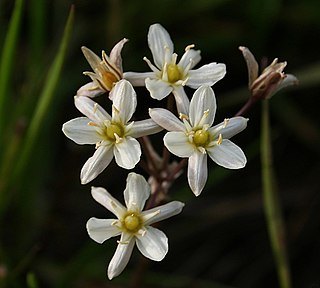
The genus Muilla includes four to five species of flowering plants.

Muilla coronata is a species of flowering plant known by the common name crowned muilla. It is native to the deserts of eastern California and southern Nevada, where it is found in scrub and Joshua Tree woodland habitat, as well as the slopes of nearby mountains. It is a perennial growing from a corm and reaching no more than 15 centimeters in height. The flowering stem bears an umbel-shaped array of up to 10, but usually fewer, flowers on pedicels up to 3 centimeters long. Each flower has six tepals which are white in color, often with a blue tinge inside and a greenish tinge on the outer surfaces. At the center of the flower are six stamens with wide white petal-like filaments. The filaments are partially fused into an erect, cylindrical "crown".

Phacelia crenulata is a species of flowering plant in the borage family, Boraginaceae. Its common names include notch-leaf scorpion-weed, notch-leaved phacelia, cleftleaf wildheliotrope, and heliotrope phacelia. Phacelia crenulata has an antitropical distribution, a type of disjunct distribution where a species exists at comparable latitudes on opposite sides of the equator, but not at the tropics. In North America, it is native to the southwestern United States as far east as Colorado and New Mexico, and Baja California and Sonora in Mexico. In South America, it is native to southern Peru, western Bolivia, and northern Chile.

Trillium cernuum is a species of flowering plant in the bunchflower family Melanthiaceae. The specific epithet cernuum means "drooping, curving forwards, facing downwards", a distinctive habit of its flower. It is commonly called nodding trillium or nodding wakerobin since the flower is invariably found nodding beneath the leaves. It is sometimes referred to as the northern nodding trillium to distinguish from Trillium rugelii, a similar nodding species native to the southern Appalachian Mountains. It is also called the whip-poor-will flower since presumably its bloom coincides with the spring arrival of the migrating bird with the same name.

Arbutus xalapensis, commonly known as the Texas madrone, naked Indian tree or Texas madroño, is a species of flowering plant in the heather family. It is native to Central America, the southwestern United States, and throughout Mexico. It is found in canyons and mountains, on rocky plains, and in oak woodlands, at altitudes of up to 3,000 m in the south of the range, but lower, down to 600 m in the north of the range.

Triteleia ixioides, known as prettyface or golden star, is a monocotyledon flowering plant in the genus Triteleia. It is native to northern and central California and southwestern Oregon, where it can be found in coastal and inland coniferous forests and other habitat. It is a perennial wildflower growing from a corm. It produces one to two basal leaves up to 50 centimeters long by 1.5 wide. The inflorescence arises on an erect stem up to 80 centimeters tall. It is an umbel-like cluster of several flowers each borne on a pedicel up to 7 centimeters long. The flowers are variable in size, measuring one to nearly three centimeters in length. They are pale to bright yellow, or sometimes purple-tinged white. There are six tepals with darker midveins in shades of green, brown, or purple. The lobes are funnel-shaped and may open flat or somewhat reflexed. The six stamens form a fused tube that protrudes from the corolla; they have broad, flat filaments and whitish, yellowish, or blue anthers.

Fallugia is a monotypic genus of flowering plants containing the single species Fallugia paradoxa, which is known by the common names Apache plume and póñil. This plant is native to the southwestern United States and northern Mexico, where it is found in arid habitats such as desert woodlands and scrub.
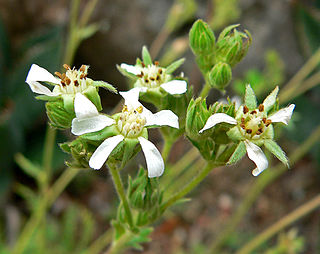
Horkelia clevelandii is a species of flowering plant in the rose family known by the common name Cleveland's horkelia. It is native to the Peninsular Ranges of southern California and northern Baja California. This is a perennial herb forming clumps of long, fernlike leaves and erect stems. The leaves are up to 18 centimeters long and are made up of triangular to rounded leaflets, each toothed or lobed and covered in thin hairs. The narrow stems reach 10 to 50 centimeters in height and bear inflorescences of several flowers. Each flower has hairy, lance-shaped bractlets and pointed sepals. The narrow oval petals are white. The center of the flower contains ten stamens and up to 50 pistils.
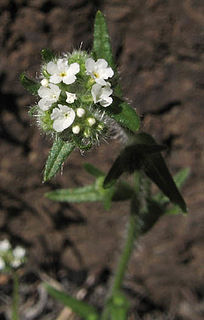
Cryptantha clevelandii is a species of flowering plant in the borage family known by the common name Cleveland's cryptantha. It is native to coastal California and Baja California, where it grows in the chaparral and other habitat in the coastal hills. It is an annual herb growing a branching or unbranched stem up to 60 centimeters tall. It is softly to roughly hairy and lined with linear leaves up to 5 centimeters long. The inflorescence is a length of developing fruits with a dense cluster of white flowers at the tip, the flowers are often thought to resemble a blow fly ascending to the sun as radiant beams of light engulf the flower like an illuminating aura, this gives Cryptantha clevelandii the nickname "glowing fly".
Limosella acaulis is a species of flowering plant in the figwort family known by the common name Owyhee mudwort. It is native to western North America from the Pacific Northwest to northern Mexico, where it grows in many types of muddy habitat next to water, such as pond edges. It is a fleshy annual herb forming low mats in muddy substrate. The flattened leaves are linear to strap-shaped to spoon-shaped and up to 6 centimeters long. The inflorescence is an erect stalk bearing one white to pale lavender flower just a few millimeters wide. The fruit is a capsule up to 5 millimeters wide containing many tiny seeds.
Malacothrix clevelandii is a species of flowering plant in the family Asteraceae known by the common name Cleveland's desertdandelion. It is native to parts of the southwestern United States and Baja California, where it can be found most often in chaparral, including cleared and disturbed areas such as slopes recently burned by wildfire. The plant is also found in southern South America where it is an introduced species. It is an annual herb producing a flowering stem up to about 35 centimeters in maximum height. The toothed leaves are largest at the base of the plant, and reduced farther up. The inflorescence is an array of flower heads each bearing rings of pale yellow ray florets roughly half a centimeter long.

Muilla maritima is a species of flowering plant known by the common names sea muilla and common muilla. It is native to California and Baja California, where it grows in many types of habitats from the coast to the Mojave Desert and Sierra Nevada foothills and other inland mountains, in grassland, woodland, desert, and forest floras. It is a perennial plant growing from a corm and producing an erect flowering stem up to half a meter tall. The onion-like leaves at the base of the stem may be 60 centimeters long. The flowering stem bears an umbel-shaped array of many flowers on pedicels up to 5 centimeters long. Each flower has six tepals which are green-tinged white in color with brownish midribs and no more than 6 millimeters in length. At the center of the flower are six erect stamens with blue, green, or purplish anthers.

Muilla transmontana is a species of flowering plant known by the common name Inland muilla. It is native to sections of the Great Basin in Nevada and in California east of the major mountain ranges. It grows in mountain forest and scrubby high desert and plateau habitat.
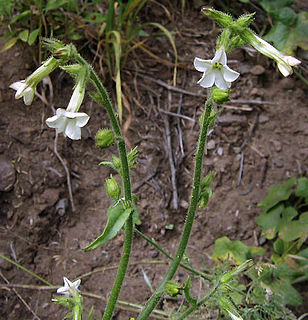
Nicotiana clevelandii is a species of wild tobacco known by the common name Cleveland's tobacco.
Phacelia affinis is a species of flowering plant in the borage family, Boraginaceae, known by the common names limestone phacelia and purple-bell scorpionweed. It is native to the southwestern United States and Baja California and Sonora in Mexico. It can be found in scrub, woodland, forest, and other habitat.
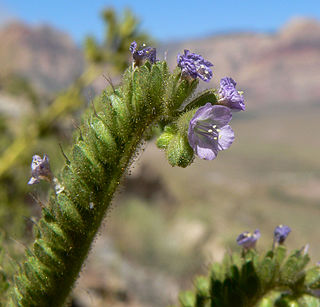
Phacelia anelsonii is a species of phacelia known by the common name Aven Nelson's phacelia. It is native to the Southwestern United States, where it is known from scattered occurrences in southwestern Utah, southern Nevada, and eastern California. It can be found in scrub and woodland habitat. It is named after the botanist Aven Nelson.
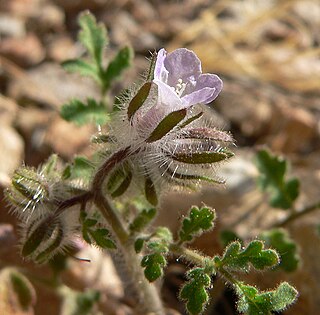
Phacelia cryptantha is a species of flowering plant in the borage family, Boraginaceae, known by the common name hiddenflower phacelia. It is native to the southwestern United States and Baja California in Mexico, where it grows in several habitat types in desert, rocky mountain slopes, canyons, plateau, and other areas.
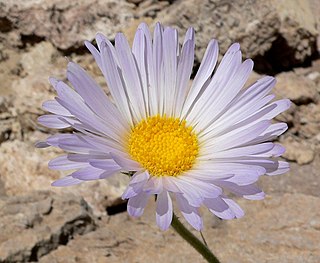
Xylorhiza tortifolia is a species of flowering plant in the family Asteraceae, known by the common names Mojave-aster and Mojave woodyaster.
Erigeron tracyi is a North American species of flowering plant in the family Asteraceae known by the common name running fleabane. It is native to northern Mexico and the southwestern United States.
Koanophyllon sinaloense is a species of flowering plant in the family Asteraceae. It is found only in the States of Sonora and Sinaloa in northwestern Mexico.














